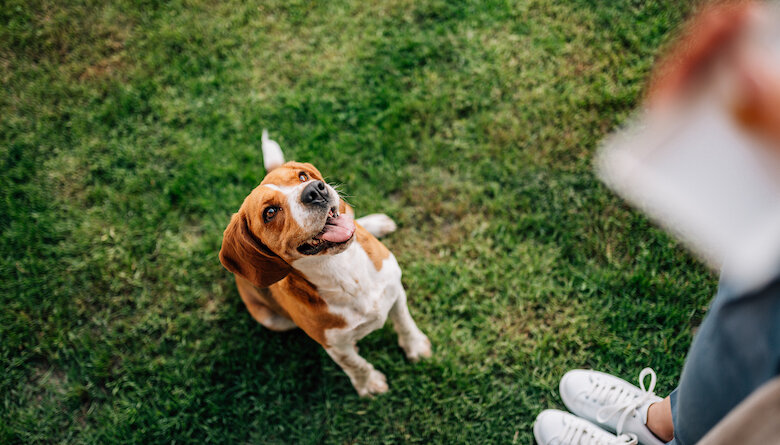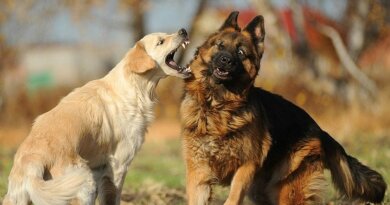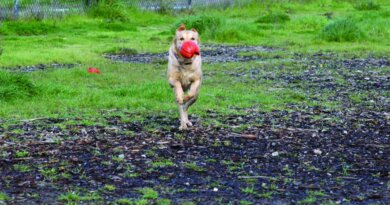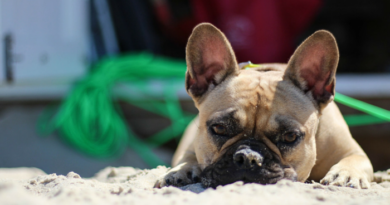‘Wait’ is One of the Most Important Cues You Can Teach Your Dog
Old-fashioned training (the kind I grew up with) was mostly “don’t do stuff” – as in “Sit, Stay, Behave!” – where “Behave” meant “Don’t do anything.” As a force free trainer, I love that now we focus on training dogs to do rather than don’t-do. Today, for our dogs, “Behave” means “Do a behavior.” Ironic, then, that one of my most-used, and most useful cues, is “Wait!”
In my dogs’ world, “Stay” means “Stay in the exact position I left you in until I release you,” while “Wait” means “Pause for a bit.” I do still sometimes give a release with Wait, but it’s far less formal than a Stay.
I use Wait multiple times a day. It’s literally a life-saver. “Wait” when I open the car door so you don’t jump out into traffic. “Wait” at the door while I walk out – you’re not coming this time. “Wait” at the top of the stairs while I go first so you don’t trip me, causing me to fall. “Wait” while we’re hiking and you spot a deer or rabbit, so you pause and I can call you back to me and you don’t get lost chasing prey off into the woods.
Related: The 10 Most Important Things to Teach A Puppy
It’s easy to teach your dog to wait. Here’s how:
Wait for the Food Bowl
- With your dog sitting, facing you, hold her bowl at chest level (with food in it, topped with tasty treats!) and say “Wait.”
- Lower the food bowl toward the floor two inches. If your dog stays sitting, click your clicker (or use a verbal marker) raise the bowl back up again, and feed her a treat from the bowl. If she gets up, say “Oops” and ask her to sit again. If she remains in place, lower the bowl two inches again, mark (click), raise the bowl, and treat.
- Repeat this step several times until she consistently remains sitting as you lower the bowl. Mark and treat each time.
- Gradually move the bowl closer to the floor with succeeding repetitions until you can place it on the floor two feet away from her and pick it back up without her getting up or trying to eat it.
- Finally, place the bowl on the floor and say a release cue like “Free!” to tell her to eat.
A really helpful thing about teaching this behavior is that you have at least one built-in daily training session (possibly two, since many of us feed our dogs twice a day).
Wait at the Door
When your dog is solid with Wait at her bowl, you’re ready to generalize the behavior. The next easy place to practice Wait is at the door. Start with your dog sitting or standing – whichever you prefer. (I prefer Sit.)
- Say “Wait” in a cheerful tone of voice. Begin to open the door just slightly. If your dog starts to go out, say, “Oops!” and close the door (be sure she won’t get caught by the door!). Say “Wait” and try opening the door again. If she stays in place, close the door mark and release. Repeat several times.
- When your dog consistently doesn’t move for a tiny crack-in-the-door opening, gradually open it wider with each trial, a little bit at a time. Mark and treat each time, but sometimes repeat another Wait without releasing.
- Practice cueing your dog to Wait, and opening the door until you can open it completely and she stays in place. Once she’s able to Wait consistently with the door wide open, take one step out. Return, close the door, mark and release.
- Gradually increase the time the door is open while your dog is still waiting. Sometimes step out and return, sometimes walk out and invite her to come with you, sometimes walk out and close the door leaving her inside (this will be an auto-release cue).
- Practice Wait every time you head out, even if she’s going to come with you. Consistency is the key to helping your dog learn quickly!
Wait on a Walk
To generalize further, practice with your dog on leash. As you’re walking, say, “Wait,” take a few more slow steps and stop. If your dog stops, mark and treat, and continue walking. If your dog continues moving after you stop, let her walk on. When she stops at the end of the leash, mark and treat, and walk on. She should quickly learn to stop when you say “Wait.”
Now, don’t wait – go train your dog!
Read Next: How to Train A Dog to Stay






Read now. Top 100 Searched Drugs.
cialis no prescription canada
Everything what you want to know about pills. Everything what you want to know about pills.
grey market darknet link drugs dark web reddit [url=https://cypher-darkmarketplace.com/ ]cypher url [/url]
bupropion 150 zyban uk wellbutrin generic for sale
deep web drug markets free dark web
best darknet markets deep web drug links
tor markets 2023 dark web market links
darknet sites dark web market list
the dark internet https://darkmarket-cypher.com/ darknet markets
Vardenafil online prescription https://levitra.eus/# Levitra 10 mg best price
Cialis without a doctor prescription https://cialis.foundation/# – Generic Tadalafil 20mg price